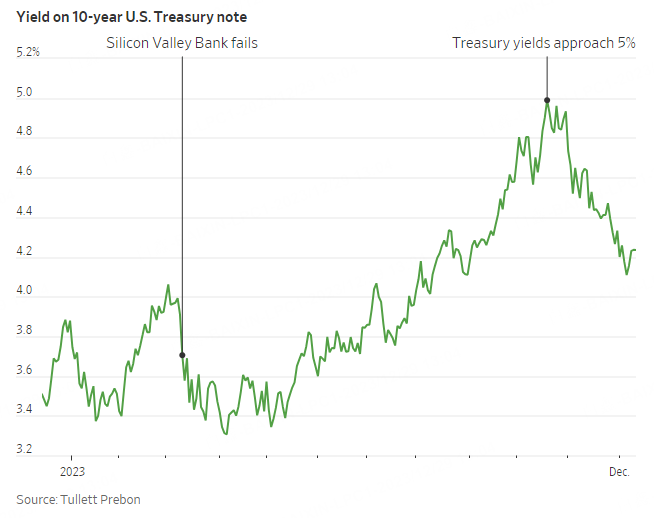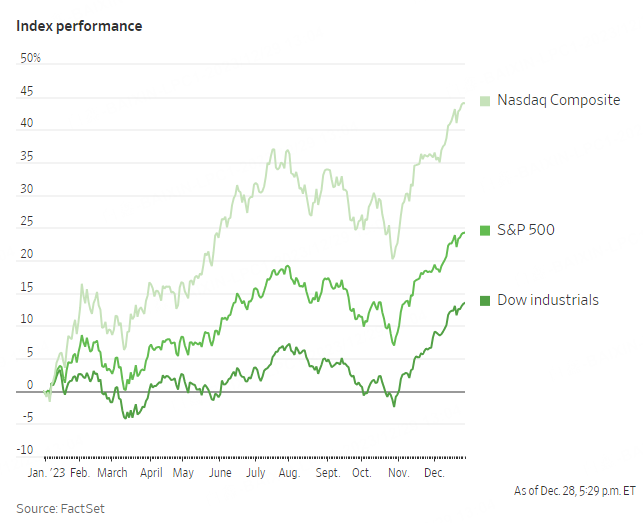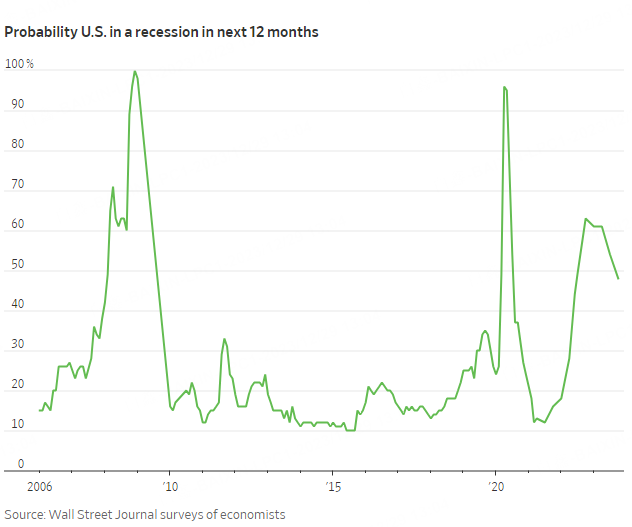Almost no one thought 2023 would be a blockbuster year for stocks. They could hardly have been more wrong.
The Federal Reserve raised interest rates at the fastest clip since the 1980s, a regional banking crisis felled Silicon Valley Bank, and war broke out in the Middle East. Yet stocks kept climbing.
The S&P 500 is poised to finish the year up 25%, just 0.3% from its January 2022 record. The Dow Jones Industrial Average advanced 14% to top 37000 for the first time and set seven record closes in the final days of 2023. A mania surrounding artificial intelligence and big technology stocks sent the Nasdaq Composite soaring 44%.
It is a far cry from the doom and gloom many were bracing for at the start of 2023.
A year ago, everyone from the strategists at Wall Street banks to rap artist Cardi B was calling for a recession. Instead, inflation continued falling, consumers kept spending and the unemployment rate fell to 3.4%, the lowest level since 1969.
In one of the biggest surprises of all, higher bond yields didn't turn out to be the boogeyman that many money managers feared. A historic bond rout -- which drove 10-year Treasury yields to 5% in October for the first time in 16 years -- sparked a stretch of stock volatility, but didn't stymie the rally for long.
Wall Street finally conceded that TINA, or the notion that "there is no alternative to stocks," was over when a record torrent of cash flooded into money-market funds, the hottest investment of the year. Stocks found a second wind when bond yields pulled back: The 10-year Treasury yield sits at 3.849%.
"When everybody's on the same side of the boat, it is time to look to the other side," said veteran investor Leon Cooperman, founder of Omega Advisors. Cooperman said he didn't anticipate the big gains in stocks, particularly among the technology behemoths that drove much of the S&P 500's advance.
"I'll be the first to admit, the stock market exceeded my expectations," Cooperman said.
Some investors say the strength shows that market moves often don't align with scary situations around the globe.
The war between Russia and Ukraine entered its second year and an attack on Israel by Hamas launched a war in the Middle East. The impact on markets was limited, and Brent crude futures fell 8.8% to $78.39 a barrel this year.
Of course, 2023 wasn't without turmoil. Soaring interest rates caught a number of regional banks flat-footed. At Silicon Valley Bank, deposits and the value of its bond portfolio fell sharply, eventually triggering a bank run and evoking memories of the global financial crisis more than a decade ago. First Republic Bank and other lenders also collapsed. Bank stocks swung wildly.
The crisis left investors on edge that something else was sure to break in the financial system. The Fed, however, quickly shored up confidence when it said depositors wouldn't lose the money they had stashed away at the lenders, stemming bank runs and averting the risk of a deeper catastrophe.
"When the Fed tightens policy that quickly, something will break," said Steve Brown, a chief investment officer at Guggenheim Investments. "Something did break, but they fixed it really quickly."
Brown says he, too, expected a recession going into 2023 and was surprised by how many Americans weren't especially sensitive to the bruising pace of interest-rate increases. They opened their wallets for everything from Taylor Swift tickets ( Taylornomics, anyone?) to flights and restaurants. And profits started growing again at the biggest U.S. companies after three quarters of declines.
To be sure, many investors say it is premature to declare the Fed has pulled off a soft landing. Some investors are predicting a downturn next year, cautioning that it takes time for rate increases to ripple through the economy. In the past 11 Fed rate-hiking cycles, recessions have typically started about two years after the central bank begins raising interest rates, according to Deutsche Bank. This hiking cycle started in March 2022.
Others remain on edge, feeling it is too early to declare victory over inflation. Interest-rate futures suggest rates will fall more than a percentage point by the end of 2024. Whether the central bank will have to slash rates because of a recession, or whether it will be able to avert a downturn, remains a point of debate.
Some strategists warn that investors' extreme optimism about the economy and markets is a cause of concern in and of itself. About two-thirds of investors recently polled by Bank of America are expecting a soft landing, a sharp about-face from the start of the year.
Goldman Sachs Group analysts, who correctly predicted that the economy wouldn't enter a recession in 2023, said they expect the S&P 500 to end 2024 at 5100, a 6.6% jump from current levels.
But if investors have learned anything from 2023, it is the difficulty of making accurate predictions about the market's next turn.
Few anticipated that a mania over artificial intelligence would help power stocks to new heights. A blockbuster earnings report from Nvidia in May crowned the graphics-chip maker as the stock market's next star and launched a frenzy around AI that persisted for much of 2023.
The enthusiasm propelled tech shares higher, helping mask poor performance in other corners of the market. Nvidia more than tripled to lead the S&P 500. The Magnificent Seven replaced FANG (or FAANG) as the favored nickname for the market's leaders. Nvidia, Apple, Microsoft, Alphabet, Amazon.com, Tesla and Meta Platforms swelled to represent about 30% of the S&P 500's market value and were responsible for much of its 2023 gains.
That left some strategists concerned about the narrow rally and the valuations commanded by those stocks. Nvidia, for example, trades at about 25 times its projected earnings over the next 12 months, while the S&P 500 trades at around 20 times future earnings, above its historic averages.
Yet in the final weeks of the year, euphoria set in when the Fed indicated it would likely shift to trimming interest rates, rather than raising them.
An "everything rally" pushed up prices of assets -- from gold to bitcoin to risky corporate bonds and investments in far-reaching corners of the stock market. The S&P 500 is poised to end the year on a nine-week winning streak, its longest such rally in nearly 20 years. Bitcoin prices more than doubled.



Comments